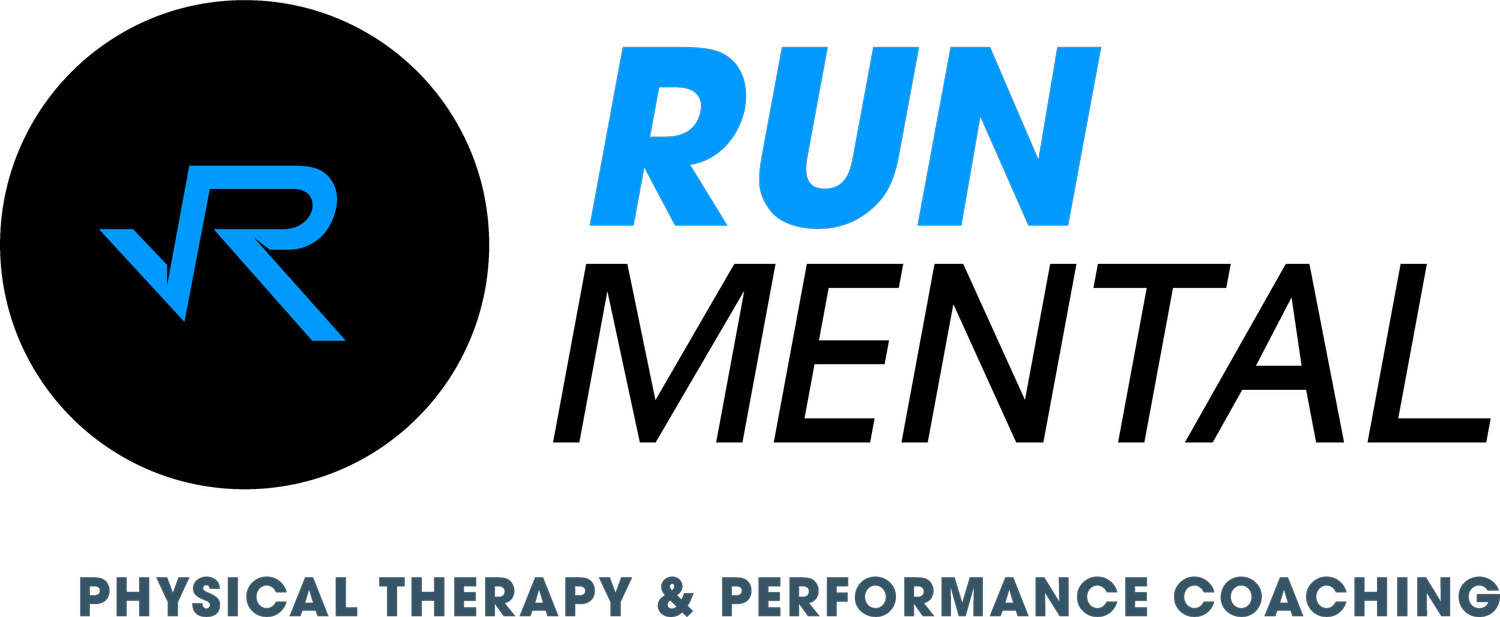Glute talk
How important are the hips in running?
Runners know they need strong glutes and mobile hips. Even relatively slow running is demanding for the body on a multitude of levels. Therefore, it makes sense to be concerned about potential weaknesses or limitations in the hip area.
Hip Mobility (Reference 1)
Unlike gymnastics, dance, or figure skating, running doesn’t require full extensibility of any muscle or full range of motion (ROM) of any joint at any point in the gait cycle. Running is what you might call a mid-range activity: you don’t need full ROM, but you do need some. One motion that receives a lot of attention is hip extension, or the ability to move your thigh backwards independent of pelvic or lumbar motion. Generally, the faster you run, the further back your leg moves behind you. But whether you are walking, running , or sprinting, you utilize only about 10 degrees of true hip extension, compared to the 20 degrees that are considered normal full ROM. When you watch someone run or look at a video, it will appear that the hip extension is much more than 10 degrees, but actually there are contributions from the pelvis tilting forward and the lower back arching a little. These actions allow for a greater amount of motion to get the leg behind you as you push off your toe, to aid in producing a propulsive horizontal force more than a more vertical one.
Hip Joint Forces (Reference 2-7)
You may be familiar with the common statistic that 2-3x your body weight (BW) hits the ground with each foot strike while running. This is measured using force plates on the ground or special treadmills that have force plates built in while someone runs over them. However, there are additional forces at play from your muscles and joint positions that contribute to increased compression, thus increasing the total amount force at a particular joint. If we start at the ground and work up, we find that the ankle experiences 5-13x your BW while running. The patellofemoral joint experiences 4x your BW. The hip, meanwhile, is only experiencing 2-3x your BW. As we move up the leg, the amount of force decreases, due to the attenuation of that impact force from our muscles, tendons, and bones as well as your shoes. Since the foot, ankle, and knee are lower in the kinetic chain, they experience more load. This is a contributing factor in the greater frequency of injuries at and below the knee than above it in distance runners.
Hip Muscle Forces (Reference 1,8,9)
One great research paper that changed how I approached strength training for runners is by Dorn et al in 2012. They looked at the activity of the primary muscles used while running at 3 different speeds. Before I came across this study, I was focused heavily on the hip, specifically the glute max (Gmax), for strength work, like many in the running community are. But this study challenges that approach.
When one is running at a 7:40/mi pace, the Gmax force peaks at ~2x your BW. That’s a lot, and something to be considerate of. Check this out though…6 of the 7 other muscles they looked at were taking on a similar load or more! This includes the glute med at ~4x BW, quadriceps at ~4.7x BW, psoas (hip flexor) at 2x BW, hamstrings at 2x BW, and soleus (lower calf muscle) at 6.7x BW. Only the anterior tibialis (muscle on the front of the shin) was lower, at ~0.5x BW. All of these numbers increase considerably an all-out sprint, but the Gmax doesn’t increase near the rate as most of the others, topping out at only 3x BW. Compare that to the hamstrings and psoas that ramp up to nearly 9x BW. Read over those numbers again and then consider why the distance running community isn’t doing more calf work. And if faster end work is more your thing, why not more hamstring and psoas work?
Additionally, when we look at the energetic cost of running at an 8:23/mi, hip extension contributes 14%, with hip flexion contributing 20%, and the ankle 41%. If you run faster, the hip extension plays a greater role-about 20% at 6:53/mi, with the Gmax being the primary muscle involved, while hip flexion contributes 25% and the ankle 34%. These measurements help us see trends as to what is happening in our bodies when we slow down or speed up.
Finally, I want to highlight a known phenomenon related to the calf muscle complex, gait changes, and aging as reported by Devita et al in 2016. Masters runners tend to show a decrease in ankle power. By “power”, I mean the amount of work you can do in a given time frame. In the world of running, this equates to the amount of force and how quickly we can generate that force. This drop in power at the level of the ankle seen in masters runners contributes to biomechanical changes such as decreased stride length, but not step rate (cadence) resulting in a decrease in velocity. (Mathematically, running speed is a function of those two factors- step rate and stride length.) However, no similar changes appear at the knee and hip, suggesting that the major decline to worry about is at the ankle. This finding reinforces the possibility that doing strength work downstream from the hip, especially on the calf, is more important than working on the hip.
The hip is under a considerable amount of load while running and needs to be strong to endure that load. However, nearly everything below the hip is encountering much greater forces. This creates an interesting case for prioritizing more work downstream unless otherwise indicated. When talking about strength work for runners, I often talk about the “big 3”: the calf, quads, and lateral (outer) hip. If you are hitting those three with a solid periodized strength program, you are likely to do well in the long term.
If you feel that you need any help structuring your run training or strength work, please don’t hesitate to reach out to me or another trusted professional. You can connect with me via phone at (719) 270-3155 or email at runmental@gmail.com. I am also active on Instagram and within my Facebook group, Strength in the Springs, where I frequently post educational material about running rehab and training.
Happy running!
References:
1. T. Novacheck. The Biomechanics of Running. Gait Posture. 1998 Jan 1;7(1):77-95
2. T. Keller, A. Weisberger, et al. Relationship between vertical ground reaction force and speed during walking, slow jogging, and running. Clin Biomech (Bristol, Avon). 1996 Jul;11(5):253-259
3. R. Burdett. Forces predicted at the ankle during running. Med Sci Sports Exerc. 1982;14(4):308-16.
4. R. Willy, L. Halsey, et al. Patellofemoral Joint and Achilles Tendon Loads During Overground and Treadmill Running. J Orthop Sports Phys Ther. 2016 Aug;46(8):664-72
5. G. Giarmatzis, I Jonkers, et al. Loading of Hip Measured by Hip Contact Forces at Different Speeds of Walking and Running. J Bone Miner Res. 2015 Aug;30(8):1431-40
6. R. Van Gent, D. Siem, et al. Incidence and determinants of lower extremity running injuries in long distance runners: a systematic review. Br J Sports Med. 2007 Aug;41(8):469-80
7. S. Messier, D. Martin, et al. A 2-Year Prospective Cohort Study of Overuse Running Injuries: The Runners and Injury Longitudinal Study (TRAILS). Am J Sports Med. 2018 Jul;46(9):2211-2221
8. T. Dorn, A. Schache, et al. Muscular strategy shift in human running: dependence of running speed on hip and ankle muscle performance. J Exp Biol (2012) 215 (13): 2347
9. P. Devita, R. Fellin. The Relationships between Age and Running Biomechanics. Med Sci Sports Exerc. 2016 Jan;48(1):98-106

